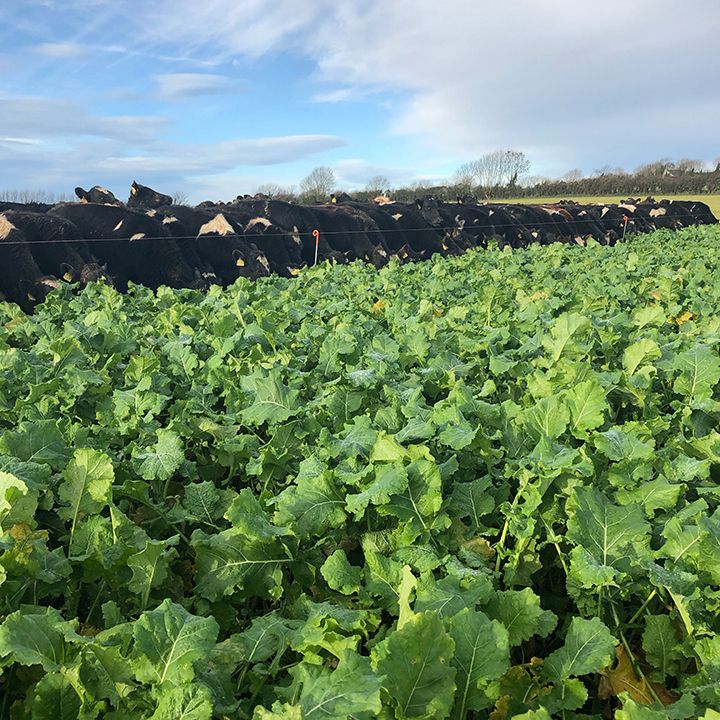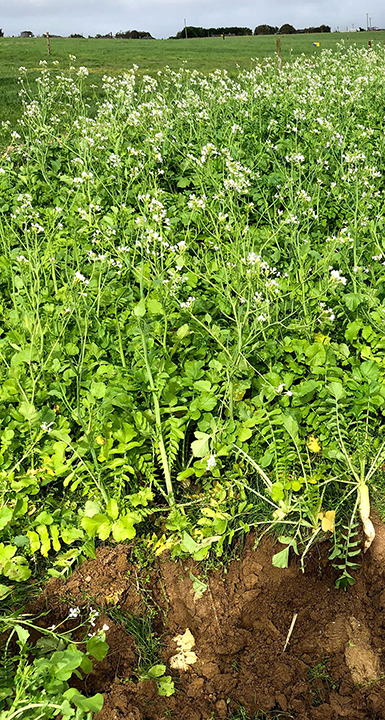A ‘cover crop’ or ‘catch crop’ is grown primarily for the purpose of ‘protecting or improving’ between periods of regular crop production. Research and use at farm level have shown that cover crops improve soil health and soil structure, reduce nutrient leaching and provide green manure for microbial activity.
 Cover crops can have a positive impact in terms of improving soil organic matter levels whether crops are reincorporated or grazed in-situ. The mix of rooting systems by different plant species can also alleviate any soil compaction issues and subsequently improve water infiltration rates. The impact of modern day agricultural practice on the wider environment is always under the spotlight; yet cover cropping can have a positive impact on flora and fauna. The canopy provided by a cover crop over winter can reduce soil loss through sedimentation significantly. Cover crops also play a part in feeding microorganisms in the soil itself. Natural plant compounds, known as root exudates, act as a feed source and result in increased earthworm populations in the soil. These earthworms play a key role in soil health and subsequent crop yield.
Cover crops can have a positive impact in terms of improving soil organic matter levels whether crops are reincorporated or grazed in-situ. The mix of rooting systems by different plant species can also alleviate any soil compaction issues and subsequently improve water infiltration rates. The impact of modern day agricultural practice on the wider environment is always under the spotlight; yet cover cropping can have a positive impact on flora and fauna. The canopy provided by a cover crop over winter can reduce soil loss through sedimentation significantly. Cover crops also play a part in feeding microorganisms in the soil itself. Natural plant compounds, known as root exudates, act as a feed source and result in increased earthworm populations in the soil. These earthworms play a key role in soil health and subsequent crop yield.
Research carried out by NIAB (National Institute of Agricultural Botany, UK) has shown a 20% increase in spring crop yields where cover crops were grown over winter. Cover crops can also provide a nutritious forage which can be grazed in-situ, but selecting the right type of cover crop is key.
Drummonds can provide a range of cover crop mixtures that comply with GLAS and Greening crop rules, but also firmly with the objective of improving soil conditions. The payment under the GLAS scheme amounts to €155/ha per year.
With so many cover crop options, some consideration needs to given before sowing. Are we looking at filling a forage deficit and also having a positive impact on the soil? If so, look at a brassica crop such as Leafy Turnip and Forage Rape. If the focus is on a ‘green crop’ that will be grown and reincorporated to the soil, Phacelia, Vetch or Mustard are options amongst others. There are different options for different systems.
The principal mixtures which Drummonds are promoting are:
SOIL BOOSTER GRAZE (2 Hectare – 16 kg pack)
A rapidly growing mixture which will quickly establish green cover. Provides a high energy feed for grazing ruminants.
6 kgs x Forage Rape
10 kgs x Leafy Turnip
Note: Clubroot could become an issue if brassicas are used as a cover crop over a period of years.
N.B. DO NOT PLANT THIS MIXTURE WHERE YOU HAVE OILSEED RAPE OR OTHER BRASSICAS IN THE ROTATION. IT IS ADVISABLE TO HAVE AT LEAST FOUR YEARS BEFORE SOWING A SECOND BRASSICA CROP IN ORDER TO MINIMISE DISEASE CARRYOVER.
KEY BENEFITS:
- Best value catch crop mixture in terms of seed cost per hectare
- Rapid growth
- Soil conditioner
- Improves soil structure
- Reduces nutrient leaching
- Suppresses weeds
- Suitable for grazing after December 1st by sheep or cattle
SOIL BOOSTER PRO (1.5 Hectare – 21 kg pack)
 Vetch quickly provides green cover and fixes Nitrogen. Phacelia is quick to establish and produces a fibrous root which helps improve soil structure.
Vetch quickly provides green cover and fixes Nitrogen. Phacelia is quick to establish and produces a fibrous root which helps improve soil structure.
18 kgs x Vetch
3 kgs x Phacelia
KEY BENEFITS:
- Fast establishment. Ideally sown in August/early September
- Nitrogen fixing
- Improves soil structure
- Suppresses weeds
In practice we have found that these two mixtures meet the vast majority of our customer requirements and we are confident in encouraging first time growers of catch crops this Autumn to plant either of these mixtures. Where required, we can make up other mixtures and/or supply the individual straights (e.g. tillage radish, mustard).
For more information please speak directly with your Drummonds Technical Sales Advisor.
